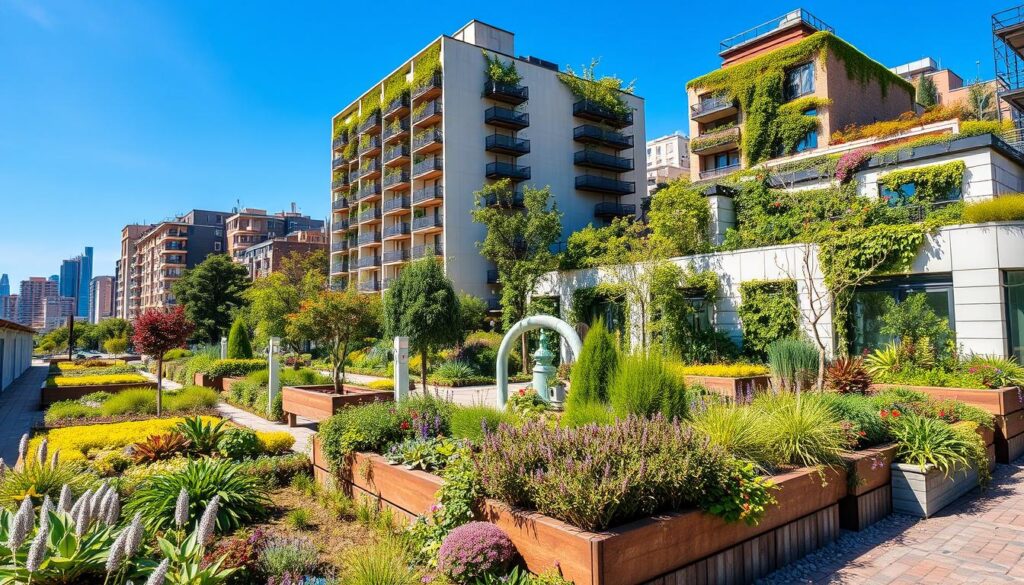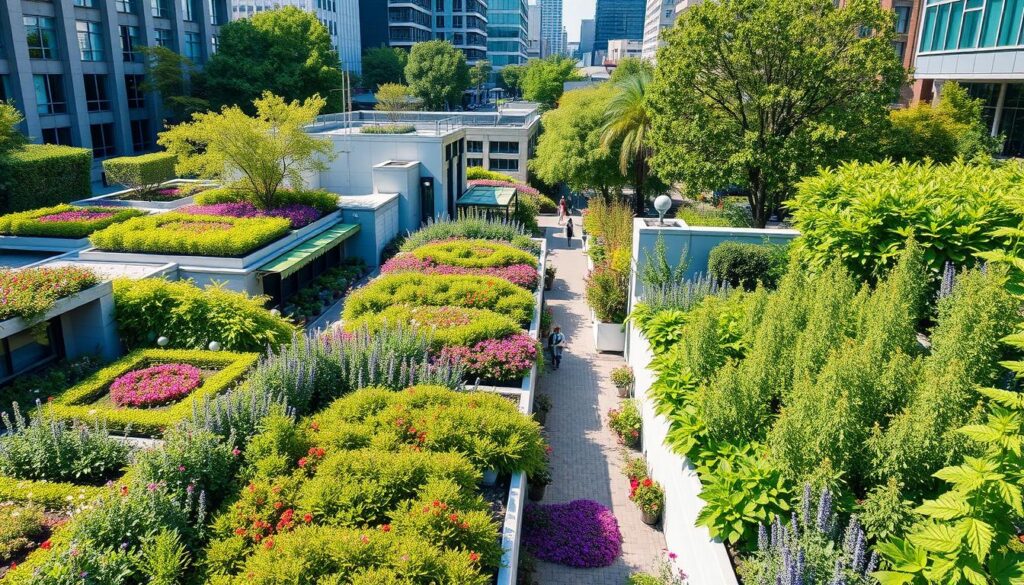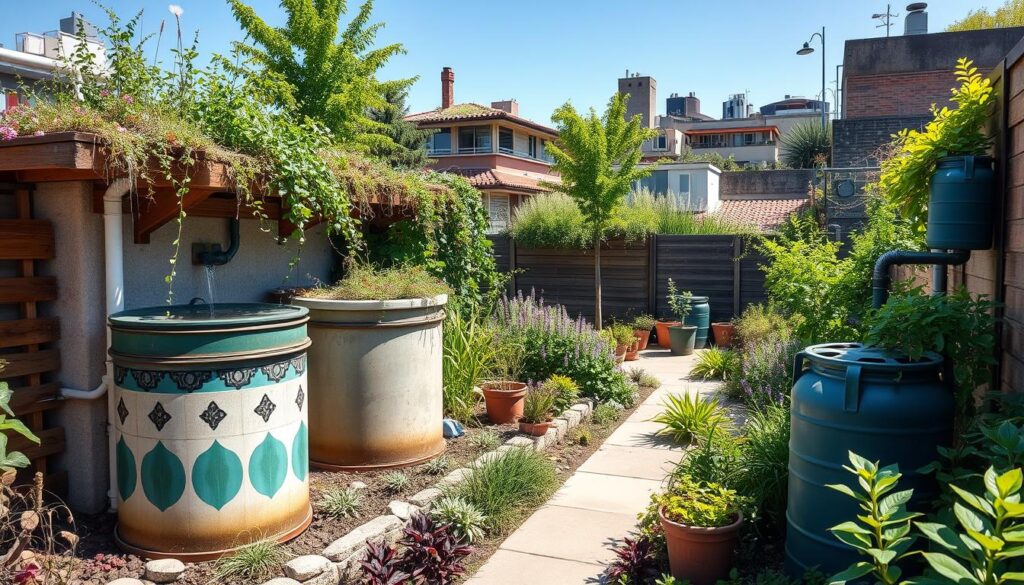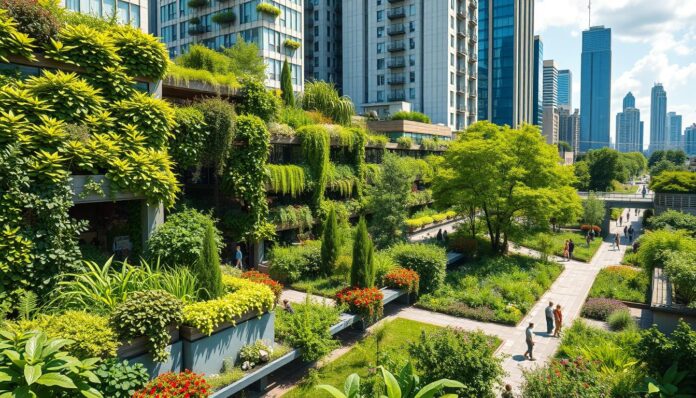Cities are growing fast, making sustainable design and ecological landscaping key. Permaculture helps build strong, green communities. It’s about using green spaces in urban planning to help the environment and people.
Most suburban areas lack green planning, showing a big need for change. Permaculture can fill this gap, bringing benefits for the planet, people, and economy.
Green spaces in neighborhoods can boost local wildlife interaction by up to 30%. People living in these areas are also 25% happier than those in regular developments.
Key Takeaways
- Permaculture infrastructure integration is essential for creating sustainable and resilient communities.
- Green infrastructure can help mitigate the adverse effects of urbanization and support biodiversity.
- Neighborhoods that integrate green infrastructure exhibit up to a 30% increase in resident interaction with local biodiversity.
- Residents living in areas with effective green infrastructure report a 25% higher satisfaction rate with their living environment.
- Sustainable design practices and ecological landscaping techniques are crucial for urban planning.
By using permaculture and green design, cities can be better for the planet and people. As more people live in cities, making them sustainable is crucial for our future.
Understanding Permaculture and Its Principles
Permaculture is a design system that aims to create sustainable and regenerative ecosystems. It is based on three key principles: earth care, people care, and fair share. These principles guide the implementation of regenerative agriculture methods, which promote biodiversity and reduce waste.
The benefits of permaculture in urban settings are numerous. It can help create sustainable food systems, reduce waste, and promote social cohesion. By incorporating green building solutions and holistic landscape design, permaculture can help mitigate the urban heat island effect and improve air quality.
Some key principles of permaculture include:
- Care for the planet
- Care for people
- Fair share
By adopting permaculture principles, individuals can create sustainable and regenerative ecosystems, even in urban areas. This approach can help reduce waste, promote biodiversity, and improve overall well-being.
| Principle | Description |
|---|---|
| Earth Care | Promote biodiversity and reduce waste |
| People Care | Promote social cohesion and community engagement |
| Fair Share | Promote equitable distribution of resources |
The Role of Infrastructure in Permaculture
Infrastructure is key in permaculture, laying the groundwork for sustainable design and ecological landscaping. Urban planners use environmental integration strategies to make spaces better for the planet and people. These efforts also boost social and economic benefits.
Urban design includes green roofs, green walls, and urban forests. These elements cut down energy use, manage stormwater, and boost biodiversity. For example, green roofs can lower energy use by 40%. Green walls help air quality and fight the urban heat island effect.

Also, using recycled materials, harvesting rainwater, and recycling greywater is sustainable. These methods can cut water use by 50% and reduce waste. Cities become more resilient and sustainable, benefiting both humans and the environment.
| Infrastructure Type | Environmental Benefits | Social Benefits |
|---|---|---|
| Green Roofs | Reduced energy consumption, improved air quality | Increased urban biodiversity, enhanced aesthetic value |
| Green Walls | Improved air quality, reduced urban heat island effect | Enhanced aesthetic value, increased property value |
| Urban Forests | Carbon sequestration, improved air quality | Increased urban biodiversity, enhanced recreational opportunities |
By adding these infrastructure elements and using sustainable design, cities can thrive. They support human well-being and environmental sustainability.
Green Infrastructure: An Overview
Green infrastructure uses natural or semi-natural systems to tackle urban environmental issues. It’s key for permaculture infrastructure integration, making ecosystems sustainable and regenerative. Examples include green roofs, green walls, and urban forests, all part of holistic landscape design.
Green infrastructure offers many benefits. It can lessen urban heat islands, manage stormwater, and boost biodiversity. For example, urban forests can cut air conditioning energy use by 30% in some areas. Green building solutions like green roofs and walls can cut surface water runoff by up to 50% compared to regular surfaces.
Examples and Benefits of Green Infrastructure
- Green roofs and walls: reduce surface water runoff and improve air quality
- Urban forests: decrease energy use and promote biodiversity
- Wetlands: reduce flooding impacts by absorbing rainwater
Supporting Permaculture
Green infrastructure aids permaculture by fostering sustainable ecosystems. It tackles urban environmental issues, boosts biodiversity, and enhances air and water quality. By adding permaculture infrastructure integration and green building solutions to urban planning, we can build more sustainable and resilient cities.
| Green Infrastructure | Benefits |
|---|---|
| Green Roofs | Reduce surface water runoff, improve air quality |
| Urban Forests | Decrease energy use, promote biodiversity |
| Wetlands | Reduce flooding impacts, improve water quality |
Integrating Green Infrastructure into Urban Planning
Cities are growing fast, with over 55% of people living in them. This makes sustainable design and green landscaping crucial. Urban areas use a lot of resources and pollute the air, showing the need for green solutions.
Green infrastructure can be added to cities through planning and community involvement. For instance, the Incredible Edible Todmorden in the UK and the Beacon Food Forest in Seattle are great examples. They show how communities can lead in making cities greener.
Benefits of green infrastructure in cities include:
- Less stormwater runoff and cleaner air
- More energy savings and cooler cities
- Better biodiversity and ecosystem services

| City | Green Infrastructure Initiative | Benefits |
|---|---|---|
| Chicago, IL | Green Alley program | Reduced stormwater runoff, improved air quality |
| Cape Town, South Africa | Rain gardens | Improved groundwater recharge, reduced urban flooding |
By using green design, landscaping, and strategies, cities can lessen their impact on the environment. This makes cities better places to live for everyone.
Designing Permaculture Spaces
Permaculture design focuses on making sustainable and regenerative ecosystems. It uses native plants, multi-functional spaces, and supports biodiversity. This method aims for long-term land health and productivity. It helps create ecosystems that support many plants and animals.
Native plants are key in permaculture design. They help local wildlife and need less care. Multi-functional spaces are also important. They let you combine things like rainwater harvesting and composting areas for a better system. These strategies help make sustainable and strong ecosystems.
- Characteristics of permaculture gardens, such as the use of native plants and multi-functional spaces
- Importance of biodiversity in permaculture design, including the creation of habitats for various species
- Role of regenerative agriculture methods in maintaining soil health and promoting ecosystem services
By using these elements and strategies, people can make thriving permaculture spaces. These spaces support both human health and the environment.
| Design Element | Benefits |
|---|---|
| Native Plants | Supports local wildlife, requires less maintenance |
| Multi-functional Spaces | Integrates various elements, creates efficient systems |
| Environmental Integration Strategies | Enables creation of sustainable and resilient ecosystems |
Rainwater Harvesting Systems
Rainwater harvesting systems are key in managing urban water. They cut down on stormwater runoff and help save water. By using sustainable design practices like green roofs and rain gardens, we can handle rainwater better. This lessens the load on city water systems.
About 50% of the world’s people face severe water shortages at some point each year. This shows how vital ecological landscaping techniques and environmental integration strategies are in city planning. Rainwater harvesting systems, with tanks from 190 to 400 liters for homes, offer a good solution.
Some main advantages of rainwater harvesting systems are:
- Less need for tap water
- Lower demand on city water systems
- More room for collecting rainwater

Adding rainwater harvesting systems to city plans boosts sustainable design practices. It also cuts down on the environmental harm caused by urban growth. This strategy can also save money on water management, making it a smart choice for cities and communities.
Soil Management in Urban Areas
Soil management is key in urban permaculture. It uses composting and mulching to make soil healthy. Regenerative agriculture methods help improve soil, grow more food, and cut down on chemical use. This also helps with green building solutions by using land wisely and reducing waste.
Holistic landscape design is important in urban areas. It looks at the whole ecosystem when planning urban spaces. This way, even small areas can become thriving ecosystems with diverse plants and trees. For more on urban permaculture, check out this resource.
Effective soil management in cities brings many benefits. These include:
- Soil that’s better for growing things
- More food and a more stable food supply
- Less need for harmful chemicals
- Healthier ecosystems and biodiversity
By using these strategies, cities can become greener and more sustainable. This helps both people and the planet.
| Soil Management Technique | Benefits |
|---|---|
| Composting | Improves soil fertility, reduces waste |
| Mulching | Retains moisture, suppresses weeds |
| Holistic Landscape Design | Supports biodiversity, ecosystem health |
Utilizing Urban Microclimates
Urban microclimates are key to boosting biodiversity and fighting urban heat islands. By tapping into these microclimates, we can make our cities greener and cooler. Permaculture infrastructure integration is vital for this, helping us design better urban spaces.
Using green roofs and walls is a smart move. They cut down on heat and offer homes to city wildlife. Sustainable design practices like these also clean the air and save energy. Plus, techniques like rainwater harvesting and greywater reuse lessen urban environmental harm.
Community gardens and urban farms are great examples. They give people fresh food and bring communities together. These spots use permaculture infrastructure integration and sustainable design practices to thrive in the city.
- Increased biodiversity
- Reduced urban heat island effect
- Improved air quality
- Reduced energy consumption
- Promoted social inclusivity
By using ecological landscaping techniques and sustainable design practices, we can build stronger, greener cities. This is done through permaculture infrastructure integration and understanding urban microclimates.
Energy Efficiency and Renewable Resources
Energy efficiency and renewable resources are key in permaculture. They help people use less traditional energy. By using green building solutions and holistic landscape design, we can make systems that are good for the planet. Environmental integration strategies are important too, as they lessen our impact on nature.
Renewable energy like solar and wind power is getting more popular in permaculture. In 2022, about 29% of the world’s electricity came from renewable sources. This move to renewables is to cut down on greenhouse gases and fight climate change.
Benefits of using energy efficiently and renewable resources in permaculture include:
* Less energy use
* Fewer greenhouse gases
* More energy freedom
* Better environmental care
* Improved holistic landscape design and green building solutions
These strategies help make permaculture systems more sustainable. They fight climate change and support environmental integration strategies.
| Renewable Energy Source | Benefits |
|---|---|
| Solar Power | Renewable, zero emissions, energy independence |
| Wind Power | Renewable, low operating costs, reduced greenhouse gas emissions |
Community Involvement and Education
Community involvement and education are key in urban permaculture. They need strategies like community engagement and educational programs. By using sustainable design practices and ecological landscaping techniques, communities can make urban areas thrive. Studies show that community gardens can cut social inequality. They can make fresh produce more accessible by up to 50% in poor areas.
Some main advantages of community involvement and education in urban permaculture include:
- More people join in on sustainable projects
- More access to fresh food in poor areas
- Stronger community bonds and resilience
By using environmental integration strategies and offering educational programs, communities can support sustainable design practices and
| Community Initiative | Benefit |
|---|---|
| Community Gardens | More access to fresh produce |
| Public Art Integration | Better community engagement and social bonds |
| Educational Programs | Support for sustainable design and ecological landscaping |
Regulatory Frameworks Supporting Integration
Effective permaculture infrastructure integration needs good regulatory support. Zoning laws and local policies are key. They help make green building and holistic landscape design possible. By tackling these rules, communities can build sustainable spaces.
Permaculture can get a boost through zoning variances and exemptions. Local policies can offer incentives like tax breaks or grants for green projects. Holistic landscape design thrives with community education and engagement. This helps people see the value of permaculture.
In Tucson, Arizona, Brad Lancaster’s rainwater harvesting work changed city policies. Working with local rules, permaculture can lead to sustainable growth.
- Permaculture infrastructure integration can increase urban landscape productivity
- Green building solutions can enhance community resilience
- Holistic landscape design can promote biodiversity and ecosystem services
By using current rules and pushing for permaculture, we can build a greener future. This approach combines green building, holistic design, and community effort.
Monitoring and Evaluating Permaculture Success
It’s key to check how well permaculture works. We look at how sustainable design, landscaping, and environmental strategies do. This helps us see what’s working and what needs a tweak.
Important things to watch include biodiversity, ecosystem services, and water quality. These show how permaculture affects the environment. For instance, good landscaping can boost biodiversity by offering homes for many species.
Tools for Continuous Improvement
There are many tools for making permaculture better. Monitoring and evaluation frameworks help spot what needs work and track progress. Tools like swales and keyline design help manage water and prevent erosion.
Gathering Community Feedback
Listening to the community is vital. It helps us see what’s working and what’s not. We can use surveys, focus groups, and meetings to hear from people.
| Metric | Description |
|---|---|
| Biodiversity | The variety of species present in an ecosystem |
| Ecosystem Services | The benefits provided by an ecosystem, such as air and water filtration |
| Water Quality | The measure of the physical, chemical, and biological characteristics of water |
By using these tools and metrics, we can keep an eye on permaculture’s success. This lets us tweak projects to make them better for the environment and the community.
Future Trends in Permaculture Infrastructure Integration
The need for sustainable urban design is on the rise. Permaculture principles will be key in shaping the future. Innovations like living walls and rooftop gardens will be crucial in creating holistic landscapes. Smart technologies, such as sensor-based systems, will also play a big role in optimizing these systems.
Innovations in Green Infrastructure
Permaculture and green infrastructure will lead to new solutions. Multifunctional green spaces will combine food production, stormwater management, and biodiversity. These innovations will help cities tackle environmental challenges while benefiting from urban permaculture.
The Role of Technology in Urban Permaculture
Technology will drive urban permaculture forward. Sensors, data analytics, and automation will allow for real-time monitoring and optimization. New technologies like vertical farming and aquaponics will also expand food production in cities.
Predictions for Permaculture’s Future in Cities
More cities will see the value of permaculture infrastructure integration. We’ll see a rise in green building solutions that support holistic landscape design. Permaculture will become a key strategy for building resilient, self-sustaining communities.

